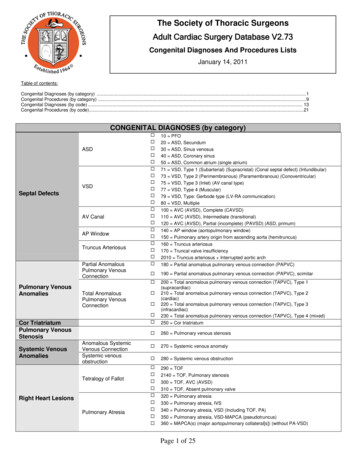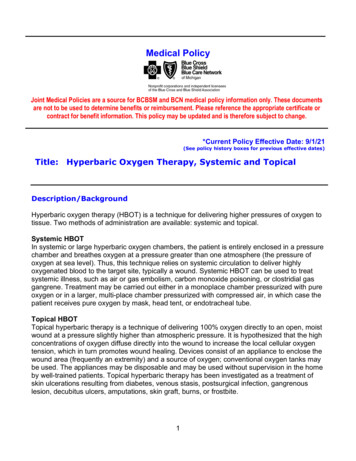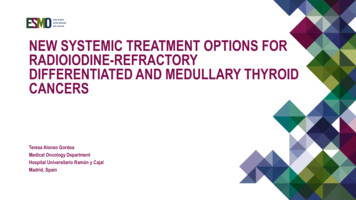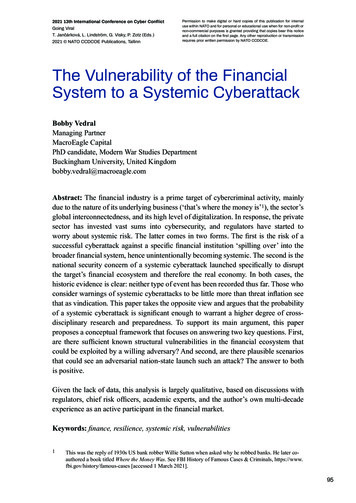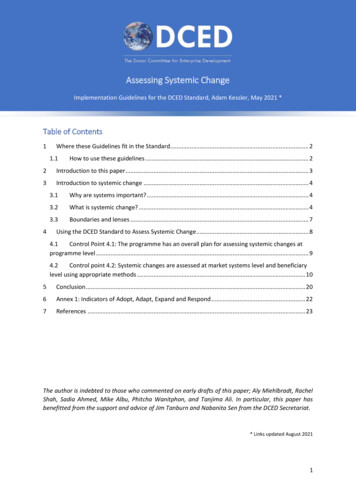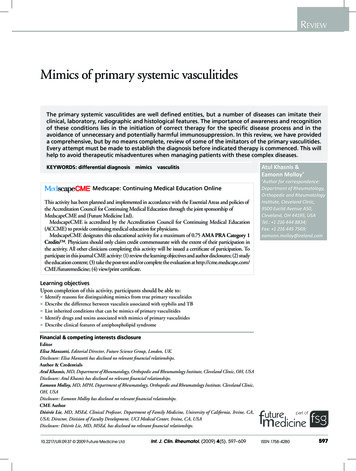
Transcription
ReviewMimics of primary systemic vasculitidesThe primary systemic vasculitides are well defined entities, but a number of diseases can imitate theirclinical, laboratory, radiographic and histological features. The importance of awareness and recognitionof these conditions lies in the initiation of correct therapy for the specific disease process and in theavoidance of unnecessary and potentially harmful immunosuppression. In this review, we have provideda comprehensive, but by no means complete, review of some of the imitators of the primary vasculitides.Every attempt must be made to establish the diagnosis before indicated therapy is commenced. This willhelp to avoid therapeutic misadventures when managing patients with these complex diseases.KEYWORDS: differential diagnosis n mimics n vasculitisAtul Khasnis &Eamonn Molloy†Author for correspondence:Department of Rheumatology,Orthopedic and RheumatologyInstitute, Cleveland Clinic,9500 Euclid Avenue A50,Cleveland, OH 44195, USATel.: 1 216 444 8834;Fax: 1 216 445 7569;eamonn.molloy@ireland.com†Medscape: Continuing Medical Education OnlineThis activity has been planned and implemented in accordance with the Essential Areas and policies ofthe Accreditation Council for Continuing Medical Education through the joint sponsorship ofMedscapeCME and (Future Medicine Ltd).MedscapeCME is accredited by the Accreditation Council for Continuing Medical Education(ACCME) to provide continuing medical education for physicians.MedscapeCME designates this educational activity for a maximum of 0.75 AMA PRA Category 1Credits . Physicians should only claim credit commensurate with the extent of their participation inthe activity. All other clinicians completing this activity will be issued a certificate of participation. Toparticipate in this journal CME activity: (1) review the learning objectives and author disclosures; (2) studythe education content; (3) take the post-test and/or complete the evaluation at http://cme.medscape.com/CME/futuremedicine; (4) view/print certificate.Learning objectivesUpon completion of this activity, participants should be able to:nnnnnIdentify reasons for distinguishing mimics from true primary vasculitidesDescribe the difference between vasculitis associated with syphilis and TBList inherited conditions that can be mimics of primary vasculitidesIdentify drugs and toxins associated with mimics of primary vasculitidesDescribe clinical features of antiphospholipid syndromeFinancial & competing interests disclosureEditorElisa Manzotti, Editorial Director, Future Science Group, London, UK.Disclosure: Elisa Manzotti has disclosed no relevant financial relationships.Author & CredentialsAtul Khasnis, MD, Department of Rheumatology, Orthopedic and Rheumatology Institute, Cleveland Clinic, OH, USADisclosure: Atul Khasnis has disclosed no relevant financial relationships.Eamonn Molloy, MD, MPH, Department of Rheumatology, Orthopedic and Rheumatology Institute, Cleveland Clinic,OH, USADisclosure: Eamonn Molloy has disclosed no relevant financial relationships.CME AuthorDésirée Lie, MD, MSEd, Clinical Professor, Department of Family Medicine, University of California, Irvine, CA,USA; Director, Division of Faculty Development, UCI Medical Center, Irvine, CA, USADisclosure: Désirée Lie, MD, MSEd, has disclosed no relevant financial relationships.10.2217/IJR.09.37 2009 Future Medicine LtdInt. J. Clin. Rheumatol. (2009) 4(5), 597–609part ofISSN 1758-4280597
ReviewKhasnis & MolloyThe vasculitides are defined by histologicalinflammation of blood vessels in various tissues.They are classified as primary or secondary andhave their identifiable causes such as infectiousagents, drug reactions, systemic autoimmune diseases or malignancy. However, in addition, thereare myriad conditions that can mimic true vasculitis clinically, on laboratory testing, on radiography and at histopathology. Distinguishingvascular inflammation from nonvasculitic disorders has significant therapeutic implications,since immunosuppressive therapy directed at theprimary systemic vasculitides may be associatedwith significant toxicities, and a failure to recognize a vasculitis mimic may delay the initiationof effective therapy for the disorder in question.For purposes of this review, the term ‘mimic’ willinclude conditions that may or may not resultin true vascular inflammation (‘vasculitis’) butpresent similarly to the defined primary systemicvasculitides. We will discuss the key categoriesof disease that may mimic the primary systemicvasculitides, focusing on a few important entitiesin each category; however, a detailed discussionof all potential vasculitis mimics is beyond thescope of this article.InfectionsDiseases caused by infectious agents can mimicany of the primary systemic vasculitides andmay affect vessels of all sizes. Acute bacterial orviral infections or chronic infections with bacteria, viruses, mycobacteria, fungi or parasitesmay mimic vasculitis. While in many cases theinfectious agents discussed can cause a true secondary vasculitis rather than being a vasculitismimic per se, they remain a critical exclusion inthe evaluation of a patient with suspected primary systemic vasculitis, not least because of thepotential of causing significant harm to patientswith active infection if they are inappropriatelytreated with immunosuppressive therapy. Forexample, syphilitic affection of the aorta resultsin true vascular inflammation but it is stillconsidered to ‘mimic’ the primary large vesselvasculitides and is treated differently. The clinical, imaging and histopathological appearanceof vascular disease caused by infectious agentsmay resemble the primary systemic vasculitides.However, infectious agents have been listed hereas a ‘mimic’ since they are distinct entities interms of well-defined etiologies, pathogenicmechanisms and therapeutic approaches. Thepresence of true vascular inflammation in theseconditions has also led to their being classifiedas ‘secondary’ vasculitides.598Int. J. Clin. Rheumatol. (2009) 4(5)SyphilisSyphilis is invoked most commonly in the differential diagnosis of the aortic and aortic branchinvolvement of the large vessel vasculitides.Cardiovascular syphilis occurs as part of thetertiary manifestations of syphilis, caused by thespirochete Treponema pallidum. Cardiovascularsyphilis presents with inflammation of the aortaresulting in aortic wall thickening, aneurysmformation, aortic valvular incompetence andcoronary artery disease. Approximately 11% ofuntreated patients progress to develop cardiovascular syphilis [1] . Aortic aneurysms occurmost commonly in the ascending aorta wherethey may be symptomatic (from pressure on thesurrounding structures) but less commonly theycan affect the descending thoracic and abdominal aorta where they are often asymptomatic.The prevalence of abdominal aortic aneurysmsvaries and most commonly involves the suprarenal aorta. Rare reported manifestations ofcardiovascular syphilis include involvement ofthe pulmonary arteries and great vessels arisingfrom the aortic arch, hepatic artery and renalartery [2] . Histopathologically, syphilitic aortitis is characterized by the collection of lympho cytes and plasma cells in the perivascular spacessurrounding the vasa vasorum in the adventitiaof the root of the aorta, a lack of ‘skip lesions’,plasma cell microabscesses and the rare occurrence of fibrinoid necrosis and sclerotic lesions(sometimes mildly inf lammatory) with orwithout thrombosis [3] . The sensitivity of theVenereal Disease Research Laboratory (VDRL)test for cardiovascular syphilis is 73% and forthe fluorescent treponemal antibody (FTA-ABS)test sensitivity is 96%. Co-existent neuro syphilismay provide a clue to the diagnosis. Syphilis canalso rarely confound the diagnosis of a smallvessel vasculitic process affecting the lungs.Syphilitic involvement of the lungs resulting innecrotizing vasculitis with gumma in the pulmonary parenchyma presenting as mass lesionshas been reported [4] .Mycobacterial infectionsTB (caused by Mycobacterium tuberculosis) canresult in granulomatous arteritis leading to vesselwall thickening, aneurysm formation and stenoses that can affect the aorta and its branches,thereby mimicking large vessel vasculitis [5] .Moreover, vasculitis may be seen at histopathology in the region of tuberculous granulomas. Involvement of the descending aorta orrenal artery may resemble Takayasu’s arteritis(TAK), especially in clinical settings where thisfuture science group
Mimics of primary systemic vasculitidespattern of aortic involvement from TAK is common [6] . Four types of TB arterial disease havebeen described: Miliary TB of the intima TB polyps attached to the intima TB involving the vascular wall TB aneurysm [7]Tuberculous aortitis may be differentiatedfrom TAK owing to its tendency to cause erosion of the vessel wall with the formation oftrue or false aneurysms, particularly affectingthe descending thoracic and abdominal aorta incontrast with arterial stenoses that are more typical of TAK [8] . The diagnosis may be suggestedby the co-existence of extrapulmonary TB.Atypical mycobacteria (Mycobacterium aviumintracellulare) have been reported to result ingranulomatous and vascular pulmonary diseaseand positive antineutrophil cytoplasmic antibodies (ANCA). The ANCA in these patientsare often of the perinuclear (P-ANCA) patternand are reactive to nonmyeloperoxidase (MPO)antigens [9] ; however, MPO-reactive P-ANCAhave been reported in this situation [10] .Infective endocarditisInfective endocarditis (IE) has the ability tomimic the entire spectrum of vasculitides clinically, radiologically and at histopathology. IEcan cause mycotic (infected) aneurysms affecting the aorta and its branches and pulmonaryarteries, as well as small vessel inflammationin various organs either from direct infection(septic vasculitis) or through immune complexmediated (purpura, glomerulonephritis [GN])or embolic mechanisms. The presence of cutaneous findings, such as ‘splinter hemorrhages’, mayalso be seen in both IE and small vessel vasculitis. In one series of patients who underwent surgical repair for aortic aneurysms, the prevalenceof mycotic aneurysms was 2.3% [11] . Mycoticaneurysms can occur in any arterial location,resulting in symptoms related to organ-specificor multiorgan ischemia and inflammation. Theaneurysms occur at major branches of the aorta,most frequently the femoral artery and abdominal aorta, followed by the thoraco–abdominaland thoracic aorta [12] . Transesophageal echocardiography can provide valuable informationby visualizing IE affecting the cardiac structures,as well as the root of the aorta and ascendingaorta [13] . Blood cultures are useful in identifyingthe responsible organism as well. GN observedin the setting of IE is typically associated withfuture science groupReview‘granular’ immune complex deposits (immunoglobulin and complement) on the subepithelialor subendothelial glomerular basement membrane seen by electron microscopy and immunofluorescence [14] in contrast with GN, occurringfrom primary systemic small vessel vasculitides,such as Wegener’s granulomatosis (WG) andmicroscopic polyangiitis, which are classicallyassociated with few to absent immune deposits(referred to as pauci-immune GN).Viral hepatitisHepatitis A infection is rarely associated withcutaneous vasculitis and cryoglobulinemia [15] .Hepatitis B (HBV), and less commonly, HepatitisC viruses (HCV), are well known to cause amedium vessel vasculitis resembling polyarteritisnodosa (PAN). The strict definition of PAN as aprimary vasculitis at this time excludes the PANlike diseases caused by viruses [16] . In a study of115 patients with HBV-associated PAN [17] , renalinvolvement was always accompanied by vasculitis in the absence of GN. ANCA was negative inall cases. Relapses were rare and never occurredafter seroconversion. A combination of antiviraltherapy and immunosuppression resulted in thebest outcomes. The major cause of death wasgastrointestinal tract involvement [17] . Orchitis,gastrointestinal and renal artery involvementresulting in hypertension are common in HBVassociated PAN, whereas cutaneous and pulmonary involvement is rare [18] . HCV can also causecryoglobulinemic vasculitis – an immune complex-mediated small vessel disease (purpura andGN) with mixed cryoglobulinemia. In a studyof 1200 patients with chronic HCV infection,cryoglobulins were observed in 40% of patientsand vasculitis developed in 1% of patients (allwith cryoglobulins) [19] . The histopathologyof cutaneous vasculitis from HCV-associatedcryoglobulinemia shows leukocytoclastic vasculitis with inflammatory infiltrates and, insome cases, fibrinoid necrosis of the arteriolarwalls and luminal thrombi. Renal involvementfrom mixed cryoglobulinemia classically resultsin Type I membranoproliferative GN. Otherdescribed pathologies include focal and mesangioproliferative GN, membranous GN andthrombotic microangiopathy [20] .Progressive multifocalleukoencephalopathyProgressive multifocal leukoencephalopathy(PML) presents with progressive cognitivedecline, altered mental status, neurologic deficitsbecame apparent upon physical examination andwww.futuremedicine.com599
ReviewKhasnis & Molloysubcortical white matter changes on MRI of thebrain, which can mimic the presentation of CNSvasculitis. It is a rapidly progressive, generallyfatal, neurological disease owing to reactivationof the John Cunningham (JC) virus polyomavirus. It has been observed in patients withmalignances on immunosuppressive therapy, butsystemic lupus erythematosus (SLE) may bearan independent predisposition to PML, even inpatients on minimal immunosuppression owingto immune dysregulation [21] . PML must be considered in the differential diagnosis of immunosuppressed patients presenting with progressiveneurological deficits, regardless of the intensityof immunosuppression, and especially if worsening occurs after increasing immunosuppression.The diagnosis can be confirmed by testing thecerebrospinal fluid for JC virus by PCR; however, brain biopsy may be needed if clinicallyindicated and PCR testing is negative.Inherited disorders Disorders of the connectivetissue matrixMarfan’s syndromeVascular involvement in Marfan’s syndrome,an autosomal dominant disorder of connectivetissue caused by mutations in the gene for fibrillin-1 (FBN1), is characterized by abnormalitiesin the wall of the thoracic aorta leading to aorticaneurysms and dissection. Aortic regurgitationoccurs in 15–44% of patients [22] . Thoracic aortic involvement from Marfan’s syndrome canmimic other etiologies of aneurysm includinggiant cell arteritis and Takayasu’s arteritis. Thelarge vessel vasculitides can be differentiatedfrom Marfan’s syndrome based on their tendency to cause arterial stenoses, their patternof vascular involvement, a lesser likelihood ofcausing arterial dissection and a lack of otheraccompanying features of Marfan’s syndrome(i.e., ocular, skeletal and cutaneous). FBN1mutations have also been described in patientswith thoracic aortic aneurysms and dissectionwithout the typical marfanoid body habitus [23] .Ehlers–Danlos syndrome type IVEhlers–Danlos syndrome type IV is anotherautosomal dominant arterial wall matrix disorder that results from mutations in the type IIIprocollagen gene (COL3A1) and may be complicated by arterial dissection or rupture, bowelperforation or organ rupture. Arterial involvement is most commonly seen in the thoracicor abdominal arteries, but carotico-cavernousfistulas, carotid artery dissection, aneurysm600Int. J. Clin. Rheumatol. (2009) 4(5)and rupture have been reported [24] . Again, inthis disease, arterial wall thickening or stenoses were not observed. The histopathology ofthe arterial wall in both Marfan’s syndromeand Ehlers–Danlos syndrome type IV is cystic medial necrosis, which clearly differs fromthe granulomatous inflammation seen with theprimary large vessel vasculitides. However, thisdistinction may be difficult to make as evidenceof active inflammation is generally only foundin approximately half of surgical specimens frompatients with large vessel vasculitides [25,26] sincesurgery is usually performed in these patientswhen the disease is considered quiescent.Loeys–Dietz syndromeLoeys–Dietz syndrome is characterized bya triad of arterial tortuosity and aneurysms,hypertelorism and bifid uvula or cleft palateowing to mutations in the TGF-b receptors(TGFBR 1 and 2). Thoracic and abdominal aortic dissections are the leading causes of death inLoeys–Dietz syndrome. The reported mean ageof dissection is 26 years and the mean age for surgical intervention for ascending aortic aneurysmor dissection is 20 years. Other arteries that canbe affected by aneurysms include the thoracic,head and neck and abdominal vessels [27] . Thebicuspid aortic valve has also been associated withaortic dissection from the possible overactivity ofmatrix metalloproteinases [28] .Genetic testing is available for mutations inFBN1, COL3A1 and TGFBR1/2 and helps toestablish the diagnosis in suspected cases. Other inherited disordersNeurofibromatosis type INeurofibromatosis type I is also an autosomaldominant disorder that may affect large- ormedium-sized vessels. Large vessel involvementcan lead to aortic dissection and rupture [29] .The most common vascular involvement inneurofibromatosis type I is renal artery stenosisresulting in hypertension. Other lesions includecerebrovascular involvement, pulmonary arterystenosis and intra-abdominal vessel involvement [30] . Vascular involvement has been classified as pure intimal, advanced intimal, intimalaneurysmal and nodular. Histopathology of theintimal subtype shows marked, concentric intimal proliferation of spindle cells with or withoutfibrosis and a thinned media. The aneurysmalsubtype demonstrates marked fibrous intimalthickening, irregular loss of media smoothmuscle and elastic fragmentation in small-sizedarteries [31] .future science group
Mimics of primary systemic vasculitidesFibromuscular dysplasiaFibromuscular dysplasia (FMD) is a non inflammatory vascular disease characterized bystenoses and aneurysm formation in multiplevascular territories, usually from medium-sizedvessel involvement. Histopathologically, FMDis classified as intimal, medial or perimedialbased on the predominant, but not exclusive,arterial wall layer involvement. Renal andcarotid arteries are most commonly involved,but other arteries may be involved in 10% ofcases. Angiographically, FMD has been classified as multifocal (‘string-of-beads’ appearance),tubular, focal and mixed [32] . Depending on thevascular territory and vessel size involved, FMDcan mimic polyarteritis nodosa or TAK. Anautosomal dominant inheritance has been suggested for renal artery involvement from FMDin a French study [33] .Grange syndromeGrange syndrome is a recently describedhereditary disorder characterized by a variable combination of multiple arterial stenosesand aneurysms, brachysyndactyly, bone fragility, learning disability and cardiac defects [34] .Arterial involvement can mimic FMD, manifesting with hypertension and angiographic ‘beading’. No clear genetic defect has yet been discovered in Grange syndrome, but an autosomalrecessive inheritance pattern has been observed.Moyamoya disease/syndromeMoyamoya disease is a vasculopathy ofunknown etiology that most commonly affectsthe cerebrovascular circulation predisposinga stroke. The classical involvement results inbilateral internal carotid artery stenosis resulting in a florid collateral circulation that, giventhe appearance of ‘a puff of smoke’ on theangiogram, the Japanese term for this appearance is ‘Moyamoya’. However, the arteries comprising the circle of Willis may also be commonly involved with ‘spontaneous occlusion’.Moyamoya disease occurs most commonly inthe Asian–American population in children andmiddle aged adults with a female predominance.The symptoms typically arise as a consequenceof vascular ischemia or hemorrhage from thecollaterals. Vascular smooth muscle cell hyperplasia and thrombosis are described at histopathology, with no evidence of vascular inflammation. Renal artery stenosis has been reportedin Moyamoya syndrome. A genetic basis hasbeen suggested based in family studies revealing increased linkage ana lysis (chromosomesfuture science groupReview3p24.2-p26, 17q25, 8q23, 6) and occurrenceof certain haplotypes (HLA-B35 in the Koreanpopulation) [35] .Cerebral autosomal dominantarteriopathy with subcortical infarctsand leukoencephalopathyCerebral autosomal dominant arteriopathy withsubcortical infarcts and leukoencephalopathy(CADASIL) is considered a typical monogenicinherited cause of stroke resulting from mutationsin the Notch3 gene [36] . Recurrent strokes mayeventually cause multi-infarct dementia. Otherpresentations include migraine and psychiatricdisturbances. MRI reveals white matter and adiffuse small vessel ischemia pattern within theperiventricular white matter, basal ganglia, thalamus, internal capsule and pons. This widespreadvascular involvement and stroke/dementia-likepresentation mimics the presentation of primaryCNS vasculitis. The angiographic picture canalso be similar due to the appearance of arterialstenoses. Histopathology reveals degenerationand loss of smooth muscle in middle- and smallsized arteries, basophilic granular degenerationof the media, vessel fibrosis, hyalinization andenlargement of perivascular spaces. The presenceof granular osmophilic material in the mediallayer on electron microscopy is pathognomonicand corresponds to the extra c ellular domainof the protein coded by the Notch3 gene onimmunohistochemistry [37] . CADASIL shouldbe suspected in the right clinical context and if afamily history is suggestive of this condition [38] .Cerebral amyloid angiopathyCerebral amyloid angiopathy (CAA) is a hereditaryor sporadic disorder characterized by deposition ofextracellular eosinophilic material (amyloid) in thecerebral vessels. Hereditary forms of CAA resultfrom mutations in various amyloid proteins (suchas cystatin C, presenilin, prion protein, transthyretin and gelsolin). Clinical presentations of CAAinclude stroke (both ischemic and hemorrhagic),subarachnoid hemorrhage, transient neurologicphenomena, cognitive impairment and dementia[39] . Histopathology demonstrates thickening ofthe small- and medium-sized arterial and arteriolar walls (and less often veins), resulting fromdeposition of an amorphous, intensely eosinophilicmaterial on light microscopy with a characteristic‘apple-green’ birefringence on polarized microscopy after Congo red staining [40] . The incidenceof CAA increases with age and even in the hereditary forms of the disease, a large variation in theage of presentation is reported.www.futuremedicine.com601
ReviewKhasnis & MolloyBox 1. Vasculitis mimics.Infection Treponema pallidum HIV Hepatitis B virus Hepatitis C virus Hepatitis A virus Mycobacteria Herpes viruses Infective endocarditis Mycotic aneurysms John Cunningham virus ProtozoaInherited disorders Disorders of connective tissue matrix– Marfan’s syndrome– Ehlers Danlos syndrome type IV– Pseudoxanthoma elasticum– Loeys–Dietz syndrome Other inherited disorders– Neurofibromatosis type I– Fibromuscular dysplasia– Grange syndrome– Moyamoya disease– Cerebral autosomal dominant arteriopathy with subcortical infarcts andleukoencephalopathy– Cerebral amyloid angiopathyDrugs/toxins Cocaine SympathomimeticsAtherosclerosis & arteriolosclerosis Hypercoagulable states– Thrombotic thrombocytopenic purpura– Antiphospholipid syndromeVasospastic disorders Reversible cerebral vasoconstriction syndrome Reversible posterior leukoencephalopathy syndromeImmunodeficiency disorders Common variable immunodeficiency HLA class I deficiencyMalignancies Leukemia Lymphoma Glioma Angiocentric lymphomaMultisystem inflammatory disease Sarcoidosis Susac’s syndromeMiscellaneous Degos disease Segmental arterial mediolysis Cardiac myxoma Calciphylaxis Cholesterol emboli syndrome Postradiation therapy Paraneoplastic602Int. J. Clin. Rheumatol. (2009) 4(5)Miscellaneousnoninherited disorders Segmental arterial mediopathySegmental arterial mediopathy (SAM), originally called segmental mediolytic arteritis, wasfirst described by Slavin in 1976 in three patientsat autopsy who were found to have large abdominal muscular arteries affected by dissectinganeurysms, partial or total mediolysis accompanied by linear fibrin deposits between the mediaand adventitia and a variable inflammatory infiltrate [41] . SAM commonly affects medium-sizedvessels in various territories (most commonly inthe abdomen) and presents as arterial dilatation,solitary aneurysm, multiple aneurysms, arterialdissections with hematomas, and arterial stenoses and occlusions. Most patients with SAM aremiddle aged to elderly individuals with an equalmale/female distribution. Patients typicallypresent with abdominal pain or retroperitonealhemorrhage owing to rupture of a visceral arteryaneurysm. SAM is hypothesized to be a partof the pathological continuum from an initialvasospastic process that may eventually evolveinto a PAN-like disease [42,43] . Radiographic[44] and clinical [43] long-term follow up studiesindicate that SAM is most likely to be an acutedisorder with resolution or unchanged arterialinvolvement over time.Drugs/toxinsA wide variety of drugs may result in mimicsof vasculitis or indeed cause a true vasculitis.A number of drugs, such as minocycline andhydralazine, may be associated with positiveANCA testing, and in some cases may be associated with a vasculitic syndrome [45] . However,cocaine use may be a particularly elusive mimicof WG. Cocaine use may result in nasal mucosalirritation and necrosis, intense vasoconstrictionleading to nasal septal perforation and collapsewith a saddle-nose deformity. These patients canpresent with facial pain, epistaxis and constitutional symptoms. In addition, they can have aclassical-ANCA pattern on immunofluorescenceand positive antiproteinase 3 (PR3) testingby immunoassay, compounding the diagnostic confusion with WG. PR3-ANCA has beenreported in up to 50% of patients with cocaineinduced midline destructive lesions [46] . However,the epitope on the PR3 molecule for ANCA inpatients with cocaine-induced lesions is differentfrom that of patients with WG. The antigen forANCA in patients with cocaine-induced lesionsis human neutrophil elastase (HNE); antibodiesfuture science group
Mimics of primary systemic vasculitidesdirected against HNE were found in patientswith cocaine-induced midline destructive lesionsby one assay in 84%, by two assays in 68%, andby all three assays in 36% (indirect immunofluorescence, direct and indirect capture ELISA) butwere not observed in patients with WG [46] . TheANCA reacting with both HNE and PR3 demonstrate a P-ANCA pattern on indirect immunofluorescence [46] . Evidence for multisystemdisease should be carefully sought and clearlyfavors a diagnosis of WG. However, the absenceof the antibodies does not preclude a diagnosisof WG. Sustained use of other vasoconstrictormedications, such as oxymetazoline and phenylypropanolamine, can also result in similar injuryto the nasal mucosa through ischemia and alsomimic chronic sinusitis owing to the occurrenceof rebound phenomena such as rhinitis medicamentosa, but will not typically be associated withpositive ANCA testing.Atherosclerosis & arteriolosclerosisAtherosclerosis is a well-defined inflammatoryvascular disease [47] , distinct from vasculitis.It is influenced by genetic factors modified bymetabolic risk factors such as diabetes mellitus, hypertension, hyperlipidemia and smoking. Atherosclerosis results in aortic aneurysms(most commonly in the infrarenal aortic segment), aortic valve sclerosis and stenoses in theaortic branches and medium-sized arteries. Itcan mimic vasculitis clinically (symptoms fromtissue ischemia and infarction, absent or weakpulses and bruits) and angiographically (focal,short segmental or diffuse arterial narrowingand aneurysms). At histopathology, atherosclerosis is characterized by ‘plaques’ consisting oflipids, inflammatory cells and platelets with orwithout thrombus. The clinical suspicion foratherosclerosis should be heightened in the relevant clinical setting in a patient with a typical clinical risk factor profile and presentation.Arteriolosclerosis is a systemic noninflammatorysmall vessel (arteriolar) disease characterized byhyalinization of the intima (hyalinosis) withproliferation and hypertrophy of the media. Itis usually silent, associated with ageing, diabetes mellitus and hypertension and is most commonly described in the renal [48] and cerebralmicrovasculature [49] . Histopathology of arteriolosclerosis consists of subendothelial proteindeposits staining bright magenta with periodic acid-Schiff stains and has a glassy texture(hyaline). Inflammatory changes do not occur distinguishing it from true vasculitis.future science groupReviewHypercoagulable states Thrombotic thrombocytopenicpurpuraThrombotic thrombocytopenic purpura (TTP) isa microvascular angiopathy that may be familial,idiopathic or secondary to medications, infectionsor organ transplantation. It is clinically characterized by microangiopathic hemolytic anemia, consumptive thrombocytopenia, renal failure, feverand altered mental status or other neurologicaldeficits [50] . All features do not need to be presentto make the diagnosis. Microvascular thrombosesin multiple vascular territories are associated withtissue infarction and hence, invoke the differentialdiagnosis of vasculitis. The pathogenesis of TTPinvolves deficient activity of a metalloproteinase(ADAMTS13) resulting in von Willebrand factor multimers with resultant platelet aggregation [51,52] . Histopathology of tissues in patientswith TTP typically demonstrates t
cutaneous vasculitis and cryoglobulinemia [15]. Hepatitis B (HBV), and less commonly, Hepatitis C viruses (HCV), are well known to cause a medium vessel vasculitis resembling polyarteritis nodosa (PAN). The strict definition of PAN as a primary vasculitis at this time excludes the PAN-like diseases caused by viruses [16]. In a study of
